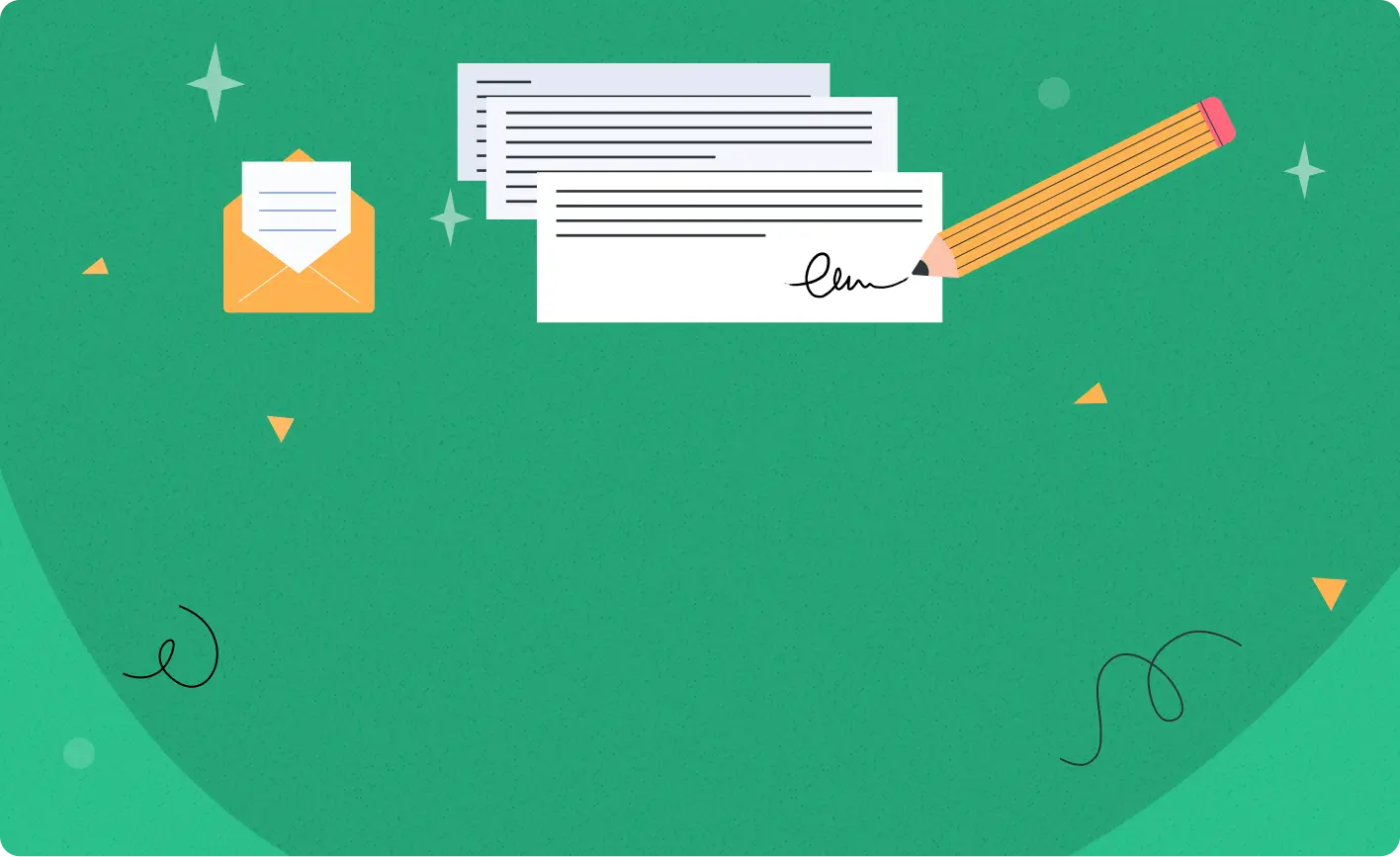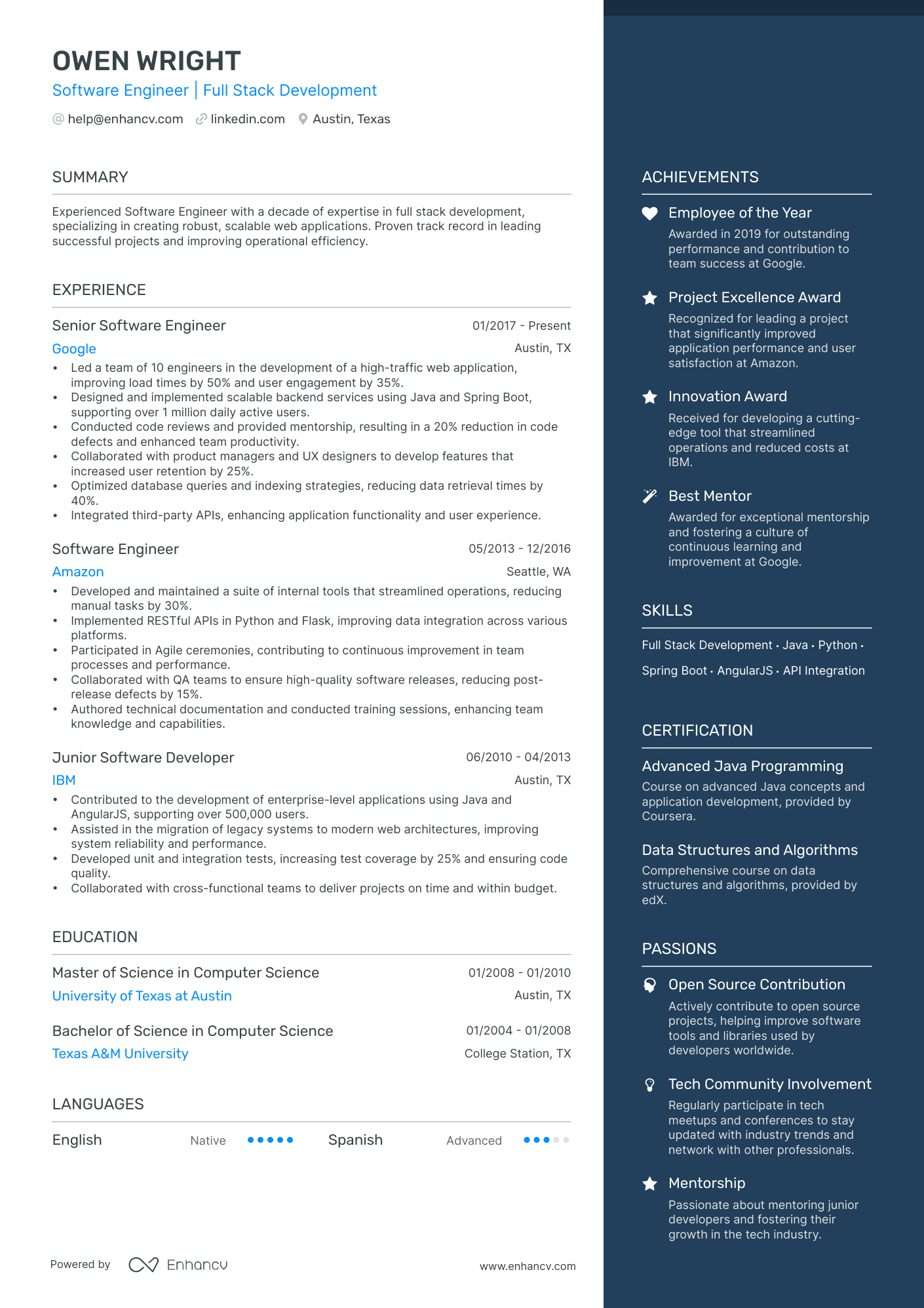A cover letter is more than just a formality—it's your chance to bring your resume to life. Think of it as a personal pitch, where you get to fill in the blanks, provide context to your experience, and show what makes you different from other candidates.
While your resume is the "what" of your qualifications, your cover letter is the "why." Together, they create a strong application that helps employers see the full picture of who you are and why you're the right fit for their company.
Think of this guide as your step-by-step map to creating a job application that impresses. We’ll cover how resumes and cover letters work together to show off your skills.
Key takeaways
- A resume provides a concise, factual overview of your professional qualifications and experience, while the cover letter is personalized, explaining your motivation and why you're a good fit for the job.
- A resume is structured in bullet points and focuses on presenting your work history and skills. At the same time, a cover letter is written in full sentences and offers more context.
- A cover letter is typically more conversational, while a resume is formal and straightforward.
- A resume often spans one to two pages, while a cover letter should always be just one page.
- Both a resume and a cover letter should be proofread carefully for errors and presented professionally.
- A cover letter complements the resume by explaining qualifications or experiences that need further detail.
Drop your resume here or choose a file.
PDF & DOCX only. Max 2MB file size.
What is a resume?
Let’s explore the basics of a resume:
A resume is a brief overview of your professional background. It’s designed to give employers a quick glimpse of your career highlights, showing your experience and qualifications. It’s commonly used when applying for jobs to help potential employers assess your suitability for the role.
What to include in a resume?
When writing a resume, it's essential to add sections that draw attention to your qualifications, skills, and experience.
Here are the key elements to consider:
- Contact information: Provide your full name, phone number, email address, and location (city and state). Optionally, add a link to your LinkedIn profile or portfolio.
- Resume summary or objective: Write a brief personal statement that outlines your career goals or summarizes your key qualifications.
- Work experience: List your previous positions in reverse chronological order, including job titles, company names, employment dates, and bullet points detailing your responsibilities and achievements.
- Education: Mention your degree(s), the institution(s), and graduation date(s). If you're a recent graduate, relevant coursework and/or academic honors can be included.
- Skills: Highlight both hard and soft skills relevant to the role, such as technical proficiencies, languages, or communication skills.
- Certifications and awards: Add any relevant certifications, licenses, or honors that demonstrate your expertise.
- Volunteer work or internships: If applicable, list unpaid experiences that showcase your skills or involvement in your field.
- Projects or portfolios: In creative or technical fields, consider adding a link to a portfolio or descriptions of relevant projects.
- Languages: If you speak multiple languages, include the language and your proficiency level.
- Hobbies and interests: Relevant hobbies can show your personality, especially for creative or people-focused roles.
- References: If not already requested, you can note that references are "available upon request."
You can write many different sections in your resume to present a well-rounded profile to potential employers. Keep it relevant, and don't be afraid to feature what makes you unique!
What is a cover letter?
A cover letter is a short, personalized letter that goes with your resume when you apply for a job. It’s your chance to introduce yourself to the employer, explain why you're excited about the role, and highlight the key reasons you're a great fit. Think of it as a way to show your enthusiasm, while giving a little more context to your experience than your resume alone can offer. It’s that personal touch that can set you apart from other candidates!
Why write a cover letter?
A cover letter gives you a chance to distinguish yourself in a crowded job market. While your resume handles the formal details, the cover letter lets you share more of your personality, passion, and motivation for the job.
It’s your way to show why you’re not just another applicant but THE person for the role. Think of it as your first conversation with the employer—where you explain not just what you’ve done, but why it makes you the missing piece for their team. It’s all about making a connection beyond the bullet points!
What to include in a cover letter?
These are the key elements you should mention when writing your cover letter:
- Header: Include your contact details and the recipient’s information (if known), as well as the date.
- Greeting: Address the hiring manager by name, or use a general salutation like "Dear Hiring Manager" if the name is unavailable.
- Introduction: Open with a clear statement about the position you're applying for and briefly mention why you're interested and suitable for the job.
- Body: Put the focus on relevant skills, experiences, or achievements that match the job requirements, and demonstrate how you can contribute to the company.
- Closing: Reiterate your interest in the role, invite the hiring manager to contact you for further discussion, and express your desire for an interview.
- Signature: End with a courteous sign-off and your name.
Key differences between a resume and a cover letter
Understanding the main differences between a resume and a cover letter is essential for creating successful job applications.
While both documents are used to present your qualifications, they serve distinct purposes and formats.
Let’s explore how a resume and a cover letter set themselves apart in five different aspects:
Content
- Cover letter: Offers a personalized introduction, provides context around your achievements, and explains why you’re the right fit for the job.
- Resume: Provides a factual and concise summary of your qualifications, work experience, and education in bullet-point form.
Format
- Cover letter: Structured like a formal letter, including a greeting, introduction, body, and conclusion.
- Resume: Organized into sections, typically mentioning work history, skills, education, and achievements, using bullet points.
Length
- Cover letter: Generally one page.
- Resume: Usually one or two pages, depending on experience.
Tone
- Cover letter: More conversational, allowing you to showcase enthusiasm and personality.
- Resume: Professional and concise, presenting information directly.
Specificity
- Cover letter: Tailored for each job, directly addressing the company and the role.
- Resume: Tailored to each job, while offering a general overview of your skills and experience.
Similarities between cover letter and resume
When preparing your job application, it’s important to understand the role that both your cover letter and resume play. Although each serves a unique function, they share some key similarities that can greatly impact your application’s success.
Here are a few crucial points to consider:
- Both serve as tools to communicate qualifications to employers: A resume and cover letter present your skills, education, and experience, helping employers assess your suitability for the role. While a resume is fact-based, the cover letter adds a personal touch.
- Both are essential components of a job application in most cases: Some job applications require both documents. The resume provides the details, while the cover letter underlines why you're the best fit for the role.
- Both need to be carefully proofread and professionally presented: Errors or poor formatting can hurt your first impression. Both documents must be well-polished to reflect professionalism and attention to detail.
Resume example
If you'd like to see more resume examples check out our library of 1800+ resumes.
The specific example below will guide you through the key sections and help you understand how to feature your skills, education, and experience.
Whether you're new to writing resumes or just looking for a little inspiration, this sample will give you a great starting point to create an impressive resume.
Now that we've covered the resume, we suggest you explore our collection of 1200+ examples of cover letters that complement this resume perfectly.
Example of cover letter for resume
Before starting your own cover letter, it's helpful to see a clear example illustrating how to craft one.
Here's a sample to guide you:
Owen Wright
45 Rosewood Drive
Austin, TX
help@enhancv.com
September 20, 2024
Hiring Manager
Bright Tech Solutions
123 Tech Avenue
Austin, TX
Dear Hiring Manager,
I am excited to apply for the Senior Software Engineer position at Bright Tech Solutions. With over a decade of experience in full-stack development and a proven track record in leading successful projects, I am confident in my ability to make a significant impact on your team. My work at Google, where I led a team of 10 engineers to develop a high-traffic web application, allowed me to improve load times by 50% and boost user engagement by 35%. I believe this hands-on experience in optimizing performance and enhancing user satisfaction aligns perfectly with the goals at Bright Tech Solutions.
Additionally, my expertise in backend development using Java and Spring Boot, coupled with my experience integrating third-party APIs, will enable me to contribute immediately to your current and future projects. I’m particularly impressed by Bright Tech’s focus on innovation, and I am eager to bring my knowledge in scalable web applications and API integrations to your dynamic team.
Thank you for considering my application. I look forward to the opportunity to discuss how my skills can contribute to the continued success of Bright Tech Solutions.
Sincerely,
Owen Wright
This cover letter emphasizes Owen’s technical expertise and leadership experience. It also connects it to the role he’s applying for at Bright Tech Solutions.
How can you tell if a cover letter will boost your application or hold you back? We’ll dive deeper into this in the next section to help you decide when a cover letter is the right move for your job search.
When to use a cover letter vs. a resume?
It can be tricky to figure out when to send both a cover letter and a resume, especially since job postings can vary. The key is understanding when each document is needed, and how they complement one another.
Cover letter usage
According to MarketSplash over 47.4% of job applicants choose to submit a cover letter only when explicitly requested by the company.
Let’s break down when you should submit a cover letter when it’s optional, and when just a resume will do.
When both are required
In most job applications, particularly for corporate roles or industries like finance, education, and law, both a cover letter and a resume are required.
This combination allows candidates to show their formal qualifications through the resume while giving them space in the cover letter to underscore personality, enthusiasm, and a specific interest in the company or role.
Employers typically request both documents to gain a full picture of the candidate.
Situations where a cover letter is optional
There are instances where a cover letter is optional but can still make a difference. Even if it’s not explicitly required, adding a cover letter allows you to make an impression, especially when applying for highly competitive positions.
In this case, submitting a cover letter is a great way to demonstrate extra effort, show initiative, and explain any gaps or career transitions that a resume alone may not adequately cover.
Scenarios when a resume is sufficient without a cover letter
In certain situations, a resume alone is sufficient, especially for roles in industries where qualifications and work experience matter more than personal expression.
For example, technical positions like software development, warehouse roles, or entry-level jobs often require only a resume. In these cases, companies focus more on skills and experience, making a cover letter unnecessary unless it’s specifically asked for in the job listing.
PRO TIP
Carefully check the job posting to see if a cover letter is required or optional. If it's optional, sending one can show extra effort and help you stand out. Always follow the instructions closely to avoid missing any important documents.
How a cover letter complements a resume
A cover letter enhances your resume by offering more depth and context to your qualifications. It allows you to go beyond the bullet points, helping potential employers better understand how your experiences and skills make you a great fit for the role.
Here are a few key ways a cover letter complements a resume:
- Expanding on experiences or qualifications that need explanation: A cover letter lets you provide context to your achievements and explain anything that may require clarification, such as employment gaps or career changes.
- Demonstrating communication skills: Your cover letter gives you the opportunity to prove your ability to communicate effectively in writing, highlighting how you convey your thoughts and ideas clearly and persuasively.
- Offering a chance to connect with the employer by addressing specific company needs: By tailoring your cover letter to the company's specific challenges or goals, you can create a more personal connection and show how you can directly contribute to their success.
Tips for writing a resume
In this section, we’ll go over the essential points you need to know for writing a resume.
- Tailor your resume to each job by aligning your skills and experiences with the job description.
- Start bullet points with action verbs like "designed," "managed," or "implemented" to make your accomplishments stand out.
- Use numbers to back up your accomplishments, such as "increased sales by 20%" or "managed a team of 10."
- Aim for a resume length of one to two pages, focusing on the most relevant experiences.
- Incorporate keywords from the job description to ensure your resume passes through Applicant Tracking Systems.
- Stick to professional fonts, clear section headings, and consistent formatting.
- Double-check for spelling and grammar mistakes, and consider asking someone else to review it.
- Focus on both technical and soft skills that align with the job you're applying for.
- Demonstrate growth in your career by showing how your responsibilities have increased over time.
These resume tips will help you craft a professional, well-structured document that captures the attention of hiring managers.
Tips for writing a cover letter
When writing a cover letter, it's your chance to show why you’re excited about the role and how your skills make you a great fit. Below are seven tips that will help you write a cover letter that gets results.
- Whenever possible, find the name of the hiring manager instead of using generic phrases like "To whom it may concern."
- Just like your resume, make sure to tailor your cover letter to the job you're applying for, emphasizing your most relevant skills and experience.
- Start with a captivating sentence that shows enthusiasm for the role and company.
- Focus on how your experience directly meets the requirements listed in the job description.
- Keep your cover letter concise, just like your resume and limit it to one page, using brief paragraphs and straightforward language to maintain clarity and readability.
- Express interest in discussing the role further and thank the hiring manager for their time.
- While maintaining professionalism, let your enthusiasm and unique traits shine through.
- Ensure your cover letter is free from spelling and grammar errors, and have someone else review it if possible.
Common mistakes to avoid when creating a resume with a cover letter
Last, but not least in this article we’ll talk about the importance of avoiding common mistakes that can hurt your chances of landing an interview.
Here's a list of key pitfalls to steer clear of:
- Avoid repeating the exact same information from your resume in your cover letter. Instead, use the cover letter to expand on your most relevant skills and achievements.
- Sending out generic resumes and cover letters for every job application is a big mistake. Tailor both documents specifically to the job description.
- Ensure that your resume and cover letter have a consistent design, font, and style to present a cohesive, professional image.
Frequently asked questions about the difference between a cover letter and a resume
What can a cover letter explain that a resume cannot?
A cover letter allows you to explain your motivation for applying, your enthusiasm for the company, and how your skills align with the job requirements. It can also provide context for career changes, employment gaps, or other unique aspects of your work history that may not be clear from your resume.
Are cover letters still necessary in 2026?
Yes, cover letters are still valuable in 2024. While not always required, they offer an opportunity to prove your personality, eagerness, and deeper qualifications, giving you a competitive edge when included with your application.
Should I put my cover letter or resume first?
Typically, the cover letter comes first, as it introduces your resume. If you're submitting them in a single file, the cover letter should be placed before the resume. However, when uploading documents separately, it doesn't matter which one is uploaded first, as long as both are included.
What not to put in a cover letter?
Avoid including irrelevant personal details, salary expectations (unless requested), negative comments about past employers, or long-winded explanations.





